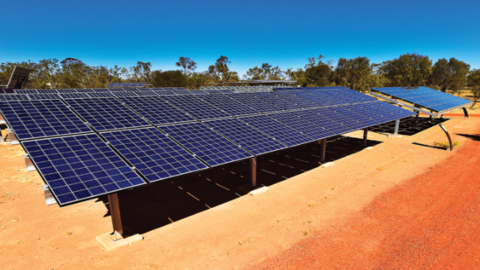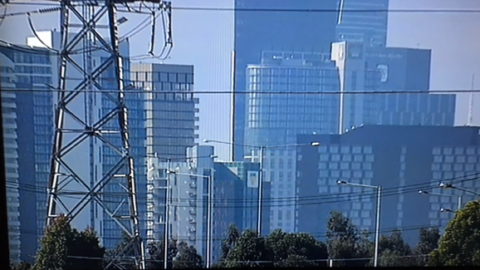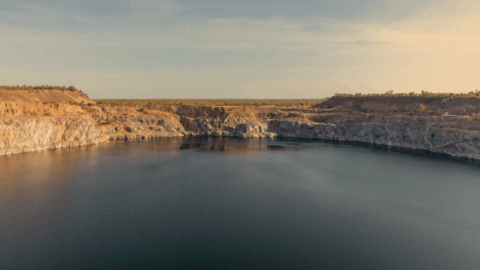Energy sustainability is a balancing act of ensuring not only that future infrastructure impacts the environment less, but also ensuring that aged infrastructure and supplies are disposed of in a conscious manner.
As Transgrid keeps sustainability top-of-mind, it is constantly looking for innovative ways to support its green goals, and in late 2022, saw an employee pitch a new aluminium recycling technology. The technology trial reduced emissions, saved time, and is continuing Transgrid’s aim to support the energy transition – as efficiently and sustainably as possible.
It was Newcastle Field Coordinator Mitch Coppock who heard a presentation about German manufacturing firm ZECK. Mr Coppock knew the ZECK Al/Steel Separator (ZAS) had potential. The ZECK Al/Steel Separator (ZAS) was released in 2020 and was described as a game changer in the recycling of transmission lines.
“It started with a simple idea after I heard the ZECK pitch and to receive the support from across the business to make it happen was really rewarding,” Mr Coppock said.
“Something like this hadn’t been done in Australia before and being part of this initiative has been exciting.”
Mr Coppock’s proposal turned into an Australian-first, with Transgrid being the first network to trial the machine in Australia. With major benefits both environmentally, and financially, the ZAS machine fits right in with Transgrid’s sustainability goals and initiatives.
High speed sustainability
By utilising the ZAS machine on site in Sydney, Transgrid is saving time, reducing its emissions, and is creating an opportunity to support local businesses with aluminium. The 2.5 tonne ZECK ZAS machine can work at high speed – more than 6km/h – and allows the full separation of steel cores of conductors from the outer aluminium layer.
Conductors are fed into the ZAS machine under tension and the outer aluminium layer is removed and cut into 30-70mm pieces, which are collected into large bags ready to be smelted into new products. The undamaged steel core is then wound onto a cable drum at the other end, ready for recycling.
Prior to the trial, used conductors would have to be shipped overseas to have their outer aluminium layer removed to be recycled but the ZAS system allows it to be done onsite. By eliminating the cost of offshore shipping, Transgrid expects to achieve a return of three times on scrap metal rates of up to three dollars a kilogram. Over the next three to five years, it is forecast to deliver two to three million dollars in extra revenue.
Keeping in regular contact leading up to the machine arriving in Sydney, ZECK even arranged for a technician from Germany to come out for the machine set up as well as to provide invaluable insights on machine use. Transgrid said having on-site support for the initial set up was key to the success of the trial because it allowed the team to iron out teething issues.
Transgrid Executive General Manager for Delivery, Craig Stallan, said the project is achieving impressive results.
“By removing the need to ship metal overseas we not only reduce emissions but can also guarantee the quality of labour that is used to process it, making it a far more transparent and ethical process,” Mr Stallan said.
“Everyone wins from this solution. Transgrid gets a much higher return on the conductor, the environment wins with reduced emissions and local businesses benefit with access to readily available and processed aluminium.
“We are proud of Mitch and our logistics team that created this great outcome for Transgrid.”
Leading the sustainable future
Transgrid is on the frontline of sustainable development, leading the nation’s transition to clean energy. “As a business, we are committed to embedding sustainability in all our activities and this project is just one of the ways we are working to identify and reduce our own environmental impact,” Mr Stallan said.
“We want to be a recognised leader in sustainability and part of that is listening and responding when our people present ideas on innovations that will help us achieve that goal together.”
For Mr Coppock, having the support of the business was a highlight of seeing the project become a reality.
“The logistics team and management were very supportive as they saw the potential benefits and it goes to show that Transgrid is always open to innovation and new ideas that will benefit how we operate,” Mr Coppock said.
Transgrid said sustainability was at the heart of the network’s role in achieving the biggest energy transformation of our lifetime – as efficiently as possible without sacrificing grid security and reliability.
The network is embedding sustainability as a key priority in project planning and delivery and in December released its inaugural Sustainability Report which will be updated each year. In June 2022 Australia’s largest electricity project, the $1.8 billion EnergyConnect interconnector which will link South Australia, Victoria, and New South Wales, became the first in Australia to reach an agreement with the International Sustainability Council.
The project set specific sustainability targets focused on reducing its carbon footprint by 20 per cent by minimising the use of energy and water, protecting biodiversity, decreasing waste, and building resilience against forecast climate impacts. For EnergyConnect, Transgrid and its construction partner SecureEnergy committed to diverting a minimum of 50 per cent of construction waste from landfill and conserving and beneficially reusing 80 per cent of spoil.
At the time Transgrid’s Executive General Manager of Major Projects, Gordon Taylor, said the agreement represented a genuine commitment to “deliver real sustainability outcomes” which will be independently measured to show performance in a clear, fair way.
“When it is finished, EnergyConnect will contribute to the decarbonisation of our economy by enabling the integration of clean, renewable generation but it is critical that our sustainability efforts begin now, during the design and construction phases,” Mr Taylor said.
Net zero by 2040
Outside of major projects Transgrid is also looking in house for ways to cut its own emissions as part of a commitment to reach net zero by 2040 (Scope 1 and 2 emissions). The target includes elimination of all emissions from the network’s pool and commercial vehicles by 2030. Each year Transgrid’s fleet collectively travels more than 14 million kilometres. So far more than half of Transgrid’s passenger fleet has transitioned to fully electric or hybrid vehicles.
In February 2023 Transgrid CEO, Brett Redman, and Federal Minister for Climate Change and Energy, Chris Bowen, launched the network giant’s trial of an electric ute for field staff. Transgrid’s first 2023 LDV eT60 electric ute is now being put through its paces for in-depth field testing around New South Wales.

Transgrid CEO, Brett Redman (L) and Federal Minister for Climate Change and Energy, Chris Bowen (R) at Transgrid’s launch of its electric ute trial for field staff.
Speaking at the launch Mr Redman said it was another example of how Transgrid is embracing sustainability through innovation and it highlighted a great opportunity to find alternative solutions thanks to emerging technologies.
“Just like how we use aerial drone technology to inspect towers, reducing the need of our people to use heavy elevated work platforms, shifting to electric vehicles will benefit the community, our customers, and the environment,” Mr Redman said.
Transgrid has also committed to using 100 per cent renewable electricity to power offices and depots by 2025. Transgrid plans to continue building upon the progress made in 2022 this year with a focus on increasing the amount of waste that can be diverted from landfill. The aluminium recycling trial is just the latest of a range of initiatives Transgrid has embraced to become more environmentally sustainable.

















